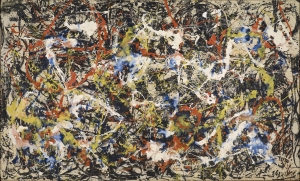Convergence is an oil painting by Jackson Pollock, from 1952. It is held at the Buffalo AKG Art Museum, in Buffalo.
| Convergence | |
|---|---|
 | |
| Artist | Jackson Pollock |
| Year | 1952 |
| Type | Abstract expressionism |
| Medium | Oil on canvas |
| Dimensions | 237 cm × 390 cm (93.5 in × 155 in) |
| Location | Buffalo AKG Art Museum, Buffalo |
Composition edit
The composition was created on canvas, measuring 93.5 inches by 155 inches. It is an oil painting in a wide range of colors, lines and shapes, made by the method of dripping and pouring paint onto a canvas.
Analysis and reception edit
These lines, spots, circles splattered on a canvas unintentionally convey the artist's emotions. The painting was made during the Cold War with Soviet Union, and it is considered that the painting represents the idea of freedom of speech.[1][2]
Other scholars, including Yve-Alain Bois, have posited that this type of individualistic interpretation fails to account for how Pollock allowed the forces of gravity and fluidity to direct the pooling and mixing of the paint.[3]
Cultural references edit
Springbok Editions made the jigsaw puzzle called Convergence in 1964 based on the Pollock's painting. The puzzle consisted of 340 pieces and it was claimed as the most difficult puzzle in the world. The puzzle gained popularity in 1965 when hundreds of thousands of Americans acquired it.[1]
See also edit
References edit
- ^ a b "Convergence, 1952 by Jackson Pollock".
- ^ "Convergence".
- ^ Bois, Yve-Alain. “Whose Formalism?” The Art Bulletin 78, no. 1 (March 1996): 11–12.